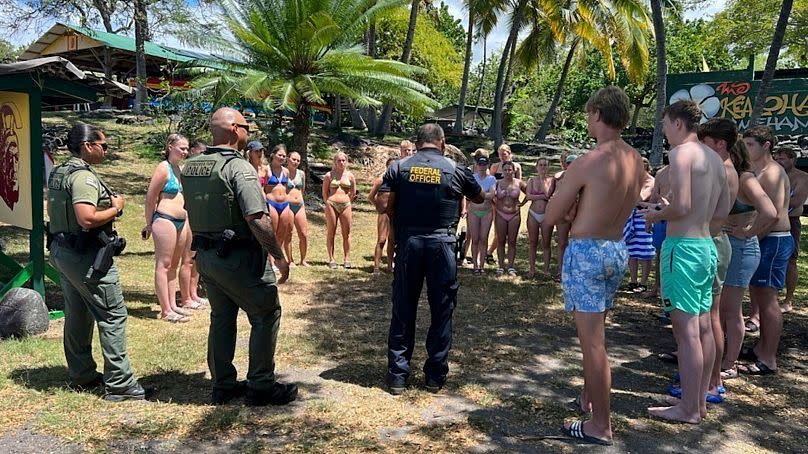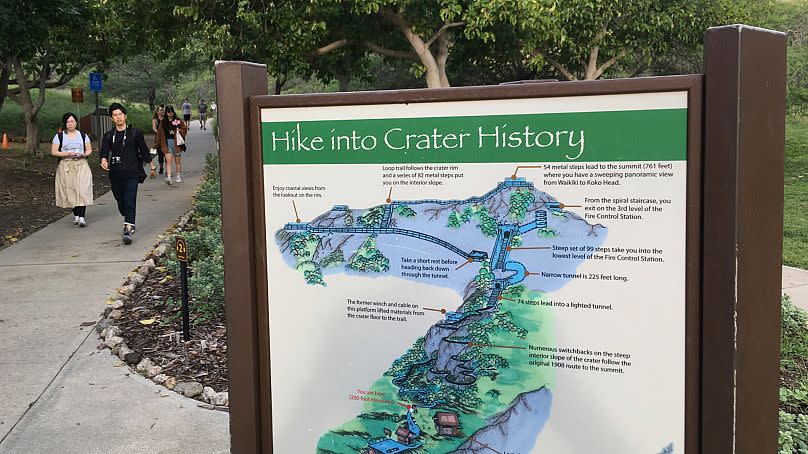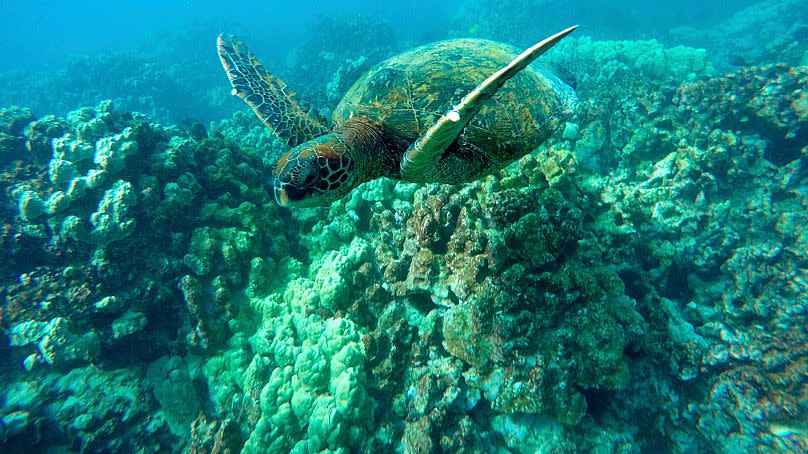'The idea is not dead': Visitor fee to protect Hawaii's delicate ecosystems rejected by lawmakers

Hawaii lawmakers failed to pass a bill that would have made tourists help pay for the protection of its delicate ecosystems.
The US island state had hoped to introduce an annual fee for tourists to visit its state parks and trails.
Although the idea has widespread public and political support, lawmakers did not resolve their differences over the measure's details in time for the deadline.
The measure would have required tourists to pay for a yearlong pass to visit state parks and trails. Revenue would have paid for the maintenance and protection of parks, coral reefs, forests and wildlife such as dolphins.
Why did Hawaii want to introduce a visitor fee?
Hawaii is a popular destination that welcomes more than nine million visitors per year, while its population numbers just 1.5 million. The state is buckling under the strain.
Coral reefs damaged from boats run aground. Native forests plagued by a killer fungus outbreak. Swimmers harassing dolphins and turtles in the ocean. These are just a few outcomes of Hawaii's overtourism problem.
Taking care of the islands' unique natural environment takes time, people and money. Now, the state wants tourists to help pay for it.
Hawaii lawmakers hoped to introduce a yearlong license to visit state parks and trails. The fee would have been set at $50 (€45).
During the past week, lawmakers discussed appropriating $360,000 (€327,222) for five full-time state employees to implement the plan but failed to reach a final agreement.
Tourism takes a heavy toll on Hawaii's delicate ecosystems
Home to around 25,000 unique species, Hawaii is one of the most biodiverse regions on Earth. It's this natural beauty that draws tourists to its shores.
But heavy footfall takes an equally heavy toll on the islands' unique natural landscape.
“All I want to do, honestly, is to make travellers accountable and have the capacity to help pay for the impact that they have,” the state's Democratic Governor, Josh Green, said earlier this year.
“We get between nine and 10 million visitors a year [but] we only have 1.4 million people living here. Those 10 million travellers should be helping us sustain our environment.”

Who would have been subject to the fee?
Green campaigned last year on a platform of having all tourists pay a $50 fee (€46) to enter the state.
Legislators thought this would violate US constitutional protections for free travel and promoted their parks and trails approach instead.
Either policy would have been a first of its kind for any US state.
In proposing the fee, Hawaii's leaders were following the example of other tourism hotspots that have imposed similar fees or taxes like Venice, Italy, and Ecuador’s Galapagos Islands.
See Amsterdam's newest campaign urging drunken British tourists to 'stay away'
Tourist taxes: All of the countries you will have to pay to enter in 2023
The Pacific island nation of Palau, for example, charges arriving international passengers $100 (€91) to help it manage a sprawling marine sanctuary and promote ecotourism.
A bill put before the state House would have required nonresidents visiting forests, parks, trails or ‘other natural area on state land’ to buy an annual license online or via mobile app. It would have applied to those aged 15 years and older. Violators would have been forced to pay a civil fine.
Residents with a Hawaii driver’s license or other state identification would have been exempt.
Why did the bill fail to pass?
Testimony overwhelmingly favored a bill. The governor and House and Senate leaders backed the concept. A 2022 public opinion survey conducted by the Hawaii Tourism Authority showed broad support for charging visitors to access state parks and trails.
Democratic state Senator Chris Lee said the bulk of the discussion at the Legislature had to do with how to have visitors pay for upkeep, improvements and protection of parks and natural resources but not whether to do so.
“I don’t think the bill failed to pass on the merits of the legislation and of the idea that we ought to be leveraging visitors to pay for these things," Lee said. "I think it was more the question of how and when.”
He expects the bill to come up for consideration again next year and for lawmakers to come together to pass it. He said there's an appetite for steps that will reduce the effects of tourism on the environment and cut costs for residents.
A spokesperson for Democratic Governor Josh Green said his administration views the bill's failure as an opportunity to have a more comprehensive discussion on managing tourism.
"With all the feedback we’ve received from this year’s legislation, we are optimistic that we can develop a detailed bill for the next session that will ensure a more sustainable future for our keiki,” said Makana McClellan, using the Hawaiian word for children.
Carissa Cabrera, project manager for the Hawaii Green Fee, a coalition of nonprofit groups supporting a fee, said the bill got farther this session than previous iterations have in the past and had more support than ever before.
“Just because the bill has died, the idea is not dead,” she said.
Social media is changing tourist behaviour in Hawaii
Hawaii State Representative Sean Quinlan, a Democrat who chairs the House Tourism Committee, says changing traveler patterns is one reason behind Hawaii's push.
He says golf rounds per visitor per day have declined 30 per cent over the past decade while hiking has increased 50 per cent.
People are also seeking out once-obscure sites that they’ve seen someone post on social media. The state doesn’t have the money to manage all these places, he says.
“It’s not like it was 20 years ago when you bring your family and you hit maybe one or two famous beaches and you go see Pearl Harbor. And that’s the extent of it,” says Quinlan. “These days it’s like, well, you know, ‘I saw this post on Instagram and there’s this beautiful rope swing, a coconut tree.’
“All these places that didn’t have visitors now have visitors,” he explains.
Do you currently have to pay to enter Hawaii's parks and trails?
Most state parks and trails are currently free but some of the most popular ones already charge.
Diamond Head State Monument gets one million visitors each year and costs $5 (€4.60) for each traveler. It features a trail leading from the floor of a 300,000-year-old volcanic crater up to its summit.
Supporters of the new fee say there's no other place in the US that imposes a similar tariff on visitors. The closest equivalent may be the $34.50 (€31.50) tax Alaska charges to each cruise ship passenger.

What would the funds be used for?
Proceeds from the licence fees would go into a “visitor impact fee special fund” managed by the state Department of Land and Natural Resources.
Carissa Cabrera, project manager for the Hawaii Green Fee, a coalition of nonprofit groups supporting the measure, said this would ensure the state has money for conservation regardless of budget swings.
Hawaii's conservation needs are great. Invasive pests are attacking the state's forests, including a fungal disease that is killing ohia, a tree unique to Hawaii that makes up the largest portion of the canopy in native wet forests.

Some conservation work directly responds to tourism. The harassment of wildlife like dolphins, turtles and Hawaiian monk seals is a recurring problem. Hikers can unknowingly bring invasive species into the forest on their boots. Snorkelers and boats trample on coral, adding stress to reefs already struggling with invasive algae and coral bleaching.
A 2019 report by Conservation International, a nonprofit environmental organisation, estimated that total federal, state, county and private spending on conservation in Hawaii amounted to $535 million (€490m) but the need was $886 million (€810m).
What do tourists think about the proposed fee?
At the Diamond Head trail recently, some visitors said the fee would make the most sense for people who come to Hawaii often or who might be staying for several weeks. Some said $50 was too high, especially for those who view a walk through nature as a low-cost activity.
“For a large family that wants to have the experience with the kids, that would be a lot of money,” said Sarah Tripp, who was visiting Hawaii with her husband and two of their three children from Marquette, Michigan.
Katrina Kain, an English teacher visiting from Puerto Rico, said she thought the fee would “sting” some people but would be fine so long as it was well-advertised.
“If tourists were informed about it, then they would be OK with it,” she said. “If that was a surprise $50 fee, it would be a pretty lousy surprise.”
Mufi Hanneman, president and CEO of the Hawaii Lodging and Tourism Association, which represents hotels, backs the bill but said Hawaii must carefully monitor how the money is used.
“The last thing that you want to see is restrooms that haven’t been fixed, trails or pathways that haven't been repaved or what have you - and year in, year out it remains the same and people are paying a fee,” Hannemann said.

 Yahoo News
Yahoo News 
